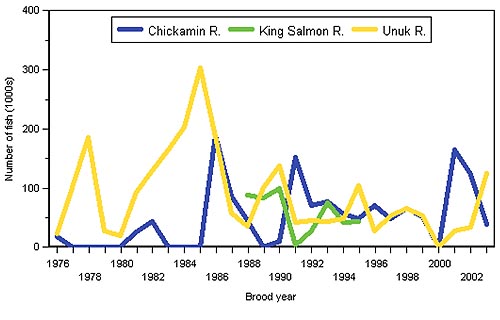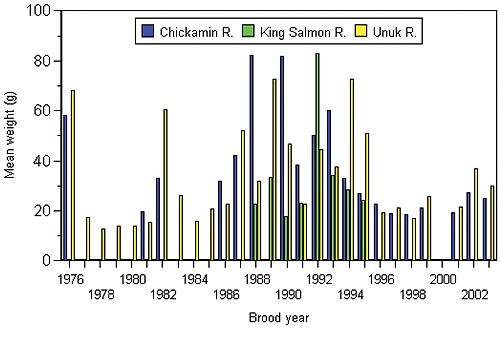Marine Salmon Interactions Program
Release of 2003 Brood Year Chinook Salmon Smolts at Little Port Walter Field Station

Figure 5. Number of chinook salmon released from Little Port Walter field station by brood year and stock.
|
Historically, smolts from three stocks of chinook salmon have been released from Little Port Walter (LPW) (Fig. 5 above); however, 2005
represented the 30th consecutive release of the stocks from the Chickamin and Unuk rivers. On 15 May, 163,823 chinook salmon
(O. tshawytscha) smolts from the 2003 brood year were released from the facility on Baranof Island in Southeast Alaska.
These smolts were tagged with coded wire tags. Of the total released, 124,871 (76.2%) were from the Unuk River stock, and 38,952
(23.8%) were from the Chickamin River stock. The survivors of the release will return to LPW at ages 2 to 7 years.

Figure 6. Mean weight (g) of chinook salmon released from Little Port Walter field station by brood year and stock.
|
The mean weight of released fish was 29.8 g for the Unuk River stock and 25.0 g for the Chickamin River stock. Sizes for chinook
salmon smolts previously released from LPW are shown in Figure 6 above. The mean weight at release for these two stocks has varied over
time due to differences in experimental constraints. More information on chinook salmon research at LPW can be accessed online at
http://www.afsc.noaa.gov/abl/MarSalm/5chhatchwild.htm.
By Adrian Celewycz
Pink Salmon Abundance, Migration Timing, and Survival for Auke Creek
Year 2005 was the 35th consecutive year of operation of the Auke Creek weir. Although pink salmon abundance was slightly above
average, and marine survival was identical to the long-term average, the timing of returns was substantially earlier than expected.
The ocean survival of pink salmon returning to Auke Creek in 2005 was 6%. These fish were produced by the 2003 brood-year spawners,
the progeny of which emigrated to the ocean as juveniles in 2004. Survival was estimated from when juveniles left Auke Creek to
when adults were captured during the return upstream migration in 2005. The average survival of Auke Creek pink salmon over the
last 35 years was also 6%. Pink salmon spawn throughout the Auke Lake system in the tributaries to Auke Lake, Auke Creek, and in
the intertidal area. Pink salmon adults were counted at Auke Creek in 1967 and 1968, and annually since 1971.
In 2005, pink salmon were counted daily as they passed through the fish-counting weir at Auke Creek from the third week of July
through mid-September, which is within the normal range of timing for Auke Creek. The escapement of 10,010 wild pink salmon was
greater than the long-term average of 7,500 and was the second earliest observed at Auke Creek. Annual counts of pink salmon adults
at Auke Creek since 1967 show the interannual variability common for this species. Pink salmon escapements at Auke Creek ranged from
300 to 28,000 over the last 38 years, and it was not unusual to see a 5- to 10-fold increase or decrease in consecutive even- and
odd-year brood lines.
In 2005, the time of return was bimodal with peak numbers occurring during the first and last weeks of August. This was a departure
from the historic pattern of pink salmon migrations at Auke Creek, when migrations usually peaked in mid-August and mid-September.
The overall midpoint of the 2005 run was 21 August, the second earliest on record for Auke Creek. The average midpoint of adult
migration for 1967-2004 was 31 August, and during the 1960s and 1970s the midpoint of the run was in September. Prespawning mortality
of adult pink salmon in Auke Creek was high because of high water temperatures. Estimates from daily recovery of fish on the fish
counting weir showed that approximately 50% of the females died before spawning.
In even- and odd-numbered years there are two distinct runs of pink salmon at Auke Creek, referred to as the early and late runs.
Because all returning fish are individually handled and are counted by sex at the fish counting weir, and due to differences in
sexual maturity, it is possible to estimate the number of fish in both runs. The start of the late run for 2005 was 31 August.
At that time, early-run females were ready to spawn while late-run females were not yet ripe, so that early run fish could be easily
distinguished when handled during counting. The early and late runs numbered 8,872 and 1,138 fish, respectively.
The larger proportion of fish in the early run continued the pattern of greater abundance of early fish, a trend which became apparent
in the mid-1980s. Before then the late even- and odd-year runs dominated the total returns of pink salmon at Auke Creek, and averaged
73% of the total return. Prior to the mid-1980s, there were often large numbers of fish into the third or fourth weeks of September.
Since the mid-1980s, the late component of runs for both even and odd years averaged about 30% of the total return, and runs have often
dwindled to low numbers and ended during the second week of September. It appears that the late-September component of the Auke Creek
pink salmon is no longer occuring.
By Jerry Taylor
 |

|
JAS2005 quarterly sidebar
AFSC Quarterly
Research Reports July-Sept 2005
Contents
Feature
ABL Reports
FMA Reports
NMML Reports
RACE Reports
REFM Reports
Items
Quarterly Index
Quarterly Home
|

